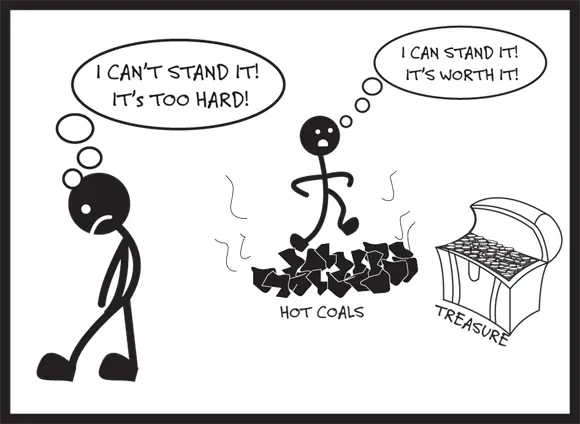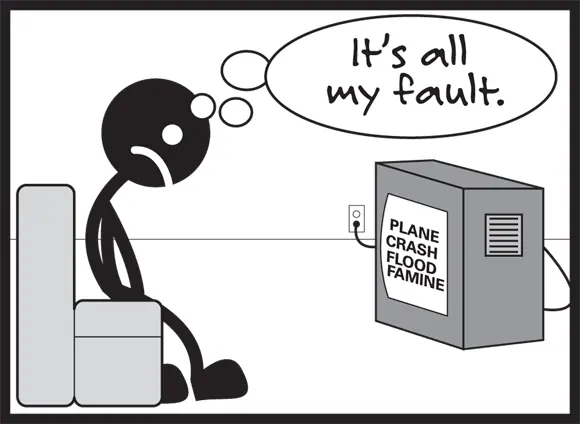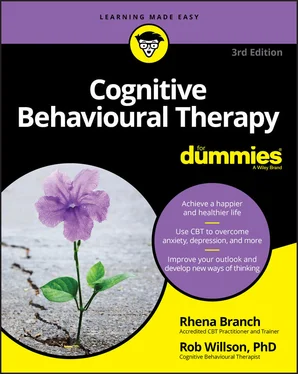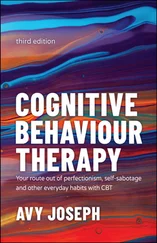 If you frequently disqualify or distort your positive attributes or experiences, you can easily sustain a negative belief, even in the face of overwhelming positive evidence.
If you frequently disqualify or distort your positive attributes or experiences, you can easily sustain a negative belief, even in the face of overwhelming positive evidence.
Low Frustration Tolerance: Realising You Can Bear the ‘Unbearable’
Low frustration tolerance refers to the error of assuming that when something’s difficult to tolerate, it’s ‘intolerable’. This thinking error means magnifying discomfort and not tolerating temporary discomfort when it’s in your interest to do so for longer-term benefit, as we show in Figure 2-11.

© John Wiley & Sons, Inc.
FIGURE 2-11:Low frustration tolerance.
The following are examples of low frustration tolerance:
You often procrastinate on college assignments, thinking, ‘It’s just too much hassle. I’ll do it later when I feel more in the mood.’ You tend to wait until the assignment’s nearly due and it becomes too uncomfortable to put off any longer. Unfortunately, waiting until the last moment means that you can rarely put as much time and effort into your coursework as you need to in order to reach your potential.
You want to overcome your anxiety of travelling away from home by facing your fear directly. And yet, each time you try to travel farther on the train, you become anxious, and think ‘This is so horrible, I can’t stand it’, and quickly return home, which reinforces your fear rather than helping you experience travel as less threatening.
The best way to overcome low frustration tolerance is to foster an alternative attitude of high frustration tolerance . You can achieve this way of thinking by trying the following:
Pushing yourself to do things that are uncomfortable or unpleasant. For example, you can train yourself to work on assignments even if you aren’t in a good mood, because the end result of finishing work in good time, and to a good standard, outweighs the hassle of doing something you find tedious.
Giving yourself messages that emphasise your ability to withstand pain. To combat a fear of travel, you can remind yourself that feeling anxious is really unpleasant, but you can stand it. Ask yourself whether, in the past, you’ve ever withstood the feelings you’re saying you presently ‘can’t stand’.
 Telling yourself you can’t stand something has two effects. First, it leads you to focus more on the discomfort you’re experiencing. Second, it leads you to underestimate your ability to cope with discomfort. Many things can be difficult to tolerate, but rating them as ‘intolerable’ often makes situations seem more daunting than they really are.
Telling yourself you can’t stand something has two effects. First, it leads you to focus more on the discomfort you’re experiencing. Second, it leads you to underestimate your ability to cope with discomfort. Many things can be difficult to tolerate, but rating them as ‘intolerable’ often makes situations seem more daunting than they really are.
Personalising: Removing Yourself from the Centre of the Universe
Personalising involves interpreting events as being related to you personally and overlooking other factors. This can lead to emotional difficulties, such as feeling hurt easily or feeling unnecessarily guilty (see Figure 2-12).

© John Wiley & Sons, Inc.
FIGURE 2-12:Personalising.
Here are some examples of personalising:
You may tend to feel guilty if you know a friend is upset and you can’t make him feel better. You think, ‘If I was really a good friend, I’d be able to cheer him up. I’m obviously letting him down.’
You feel hurt when a friend you meet in a shop leaves quickly after saying only a hurried ‘hello’. You think, ‘He was obviously trying to avoid talking to me. I must have offended him somehow.’
You can tackle personalising by considering alternative explanations that don’t revolve around you. Think about the following examples:
Imagine what else may contribute to the outcome you’re assuming personal responsibility for. Your friend may have lost his job or be suffering from depression. Despite your best efforts to cheer him up, these factors are outside your control.
Consider why people may be responding to you in a certain way. Don’t jump to the conclusion that someone’s response relates directly to you. For example, your friend may be having a difficult day or be in a big hurry – he may even feel sorry for not stopping to talk to you.
 Because you really aren’t the centre of the universe, look for explanations of events that have little or nothing to do with you.
Because you really aren’t the centre of the universe, look for explanations of events that have little or nothing to do with you.
GETTING INTIMATE WITH YOUR THINKING
Figuring out which thinking errors you tend to make the most can be a useful way of making your CBT self-help more efficient and effective. The simplest way of doing this is to record your thoughts whenever you feel upset and note what was happening at the time. Remember the maxim: When you feel bad, put your thoughts on the pad! See Chapter 3for more on managing unhelpful thoughts by writing them down (or recording them on your phone or tablet).
You can then review your thoughts against the list of thinking errors in this chapter. Write down beside each unhelpful thought the specific thinking error you’re most probably making. With practice you can get better at spotting your thinking errors and challenging them. In all probability, you may notice that you’re more prone to making some errors than others; therefore, you know which alternative styles of thinking to develop.
You may also become aware of patterns or themes in the kinds of situations or events that trigger your negative thoughts. These can also help you to focus on the areas in which your thoughts, beliefs and attitudes need the most work.
Chapter 3
IN THIS CHAPTER
 Identifying the thoughts underpinning the way you feel
Identifying the thoughts underpinning the way you feel
 Questioning your negative thoughts and generating alternatives
Questioning your negative thoughts and generating alternatives
 Using the ABC self-help forms to manage your emotions
Using the ABC self-help forms to manage your emotions
In your endeavours to become your own CBT therapist, one of the key techniques you use is a tool known as an ABC form, which provides you with a structure for identifying, questioning and replacing unhelpful thoughts using pen and paper.
CBT therapists sometimes use similar tools to the ABC form which we offer in this chapter. All these tools can help patients to identify and replace negative thoughts. Different therapists may refer to these forms as thought records, thought diaries, daily records of dysfunctional thoughts or dysfunctional thought records (DTRs). Fret not – in general, all of these forms are simply different ways of saying largely the same thing: Your thinking impacts your feelings and actions.
Читать дальше

 If you frequently disqualify or distort your positive attributes or experiences, you can easily sustain a negative belief, even in the face of overwhelming positive evidence.
If you frequently disqualify or distort your positive attributes or experiences, you can easily sustain a negative belief, even in the face of overwhelming positive evidence.

 Identifying the thoughts underpinning the way you feel
Identifying the thoughts underpinning the way you feel










